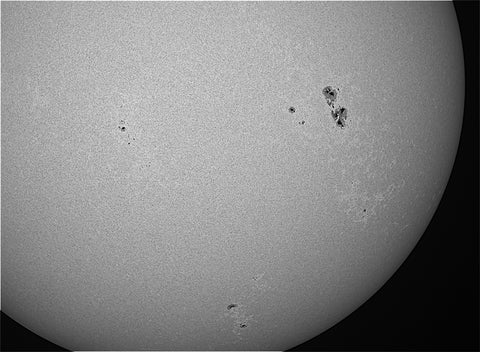Baader Calcium GEN-II 1¼" with LPFC
| Article number: | CAKII |
| Availability: | More on the Way to us |
| Delivery time: | More on the Way to us |
- Single filter (unstacked!), shows finest solar details in calcium K (Cak) lightFor solar photography only in combination with enclosed AstroSolar photo film ND3.8 or an Herschel prism (sold seperately: Baader Safety CoolCeramic Herschel Prism 2" Photographic (#2956510P)
- Enhanced contrast matched to quantum efficiency and s/n ratio of typical CMOS cameras.
- Reflex-Blocker™ coatings, for maximum immunity to retro-reflection from nearest auxiliary optics, even under the most adverse conditions
- Identical filter thickness to existing standards, with utmost care for homofocality
Reflex-Blocker™ hard coated and planeoptically polished – with sealed coating edges (Life-Coat™) - Blackened edges all around, with filter-lead-side-indicator in the form of a telescope-sided black outer rim
- Supplied with AstroSolar photo film ND 3.8, size: 200 x 290 mm - for pre-filtering sunlight
- The calcium filter Gen-II must NOT be used in the light path WITHOUT pre-filtering.
- Visual observation is not possible with the calcium filter, as the eye is practically blind in this part of the spectrum. Never point the telescope directly at the sun with only the calcium filter (without an additional attenuation filter).
Calcium GEN-II Filter 1¼" with Low Profile Filtercell
The calcium GEN-II filter lets you observe the interesting border region between the photosphere, which is visible in white light, and the chromosphere of the sun, which is reserved for narrow-band H-alpha filters. In addition to the structures known from white light, such as sunspots, you can see the chromospheric network distributed over the entire surface of the sun, which precedes the formation of sunspots, as well as cells of supergranulation and Ellerman Bombs.
The emission line of calcium at 394 nm is already in the near UV. That's why observing the sun at this wavelength is only possible with a camera! Never use this filter for visual observations, as our eye is blind for the harmful UV-radiation, but can be damaged by it.
This filter delivers the best results when used with a monochrome camera (which is more sensitive in this part of the spectrum than a colour camera) and mirror telescopes (because especially refractors with fast f/ratios are not optimized for best sharpness in this part of the spectrum). Nevertheless, many lens telescopes still work fine for calcium observations; unmodified DSLRs may need extremely long exposure times.
All calcium-filters require an additional solar filter in front of them. Part of the Baader GEN-II is a sheet of AstroSolar Photo Film OD 3.8, 20x30 cm (#2459278) to build a solar filter by yourself, so that you can start observing without purchasing any other filters. Of course, you can also use one of the BDSF: Baader Digital Solar Filter OD 3.8 (80mm - 280mm) which are already mounted in a filter cell. On suitable lens telescopes, you can also use a Herschel prism. That way, you can replace the integrated ND3-filter mounted behind the Herschel with a weaker filter to reach shorter exposure times. These filters are already in the scope of delivery of the Baader Safety CoolCeramic Herschel Prism 2" Photographic (#2956510P) .
The calcium GEN-II replaces the older K-Line Filter 1¼" (stacked) # 2458355. Thanks to modern manufacturing techniques, a single filter now achieves a better quality and narrower half-band width (FWHM) of only 5 nm instead of the previous 8 nm; stacking two filters is now no longer necessary. This also makes it possible to use the filter in standard filter wheels/drawers; the low-profile filter mount is only 6 mm high when screwed in.
The Baader Calcium GEN-II also offers all the advantages of the CMOS-optimized Baader filters:
- Increased contrast, matched for typical CMOS quantum efficiency and s/n ratio
- Reflex-Blocker™ coatings, for largest ever freedom from halos, even under most adverse conditions concerning aux-optics
- Identical filter thickness to existing standards, with utmost care for parfocality
- Blackened edges all around, with filter-lead-side-indicator in the form of a black frontside outer rim, to additionally eliminate any reflection due to light falling onto the edge of a filter
- Each filter coated individually, with sealed coating edge (NOT cut out of a larger plate with coatings left exposed, read more)
- Life-Coat™: evermore hard coatings to enable a non-aging coating for life – even in a most adverse environment


To use the 1¼"-filter at cameras with 2"-nosepiece, you can use either use a filter drawer like the Baader UFC System or a filter wheel. You can always use the filter thread of many barlow lenses as well as 1¼" nose pieces like Baader 1¼" T-2 nosepiece with Safety Kerfs (#2458106) . You can mount it between two parts with T-2-threads by combining Baader Double T-Filterholder 1¼" (#1508030) and Baader T-2Conversion Ring (#2958110) ; for cameras with a 2" filter thread, you also need Baader Expanding Ring T-2f / M48m (T-2 part #29) (#2458110 .
Limited-Lifetime-Warranty for CMOS-optimized Baader filters
A Baader Planetarium exclusive. Filters incorporating Baader Planetarium’s Life-Coat™ technology are so durable that Baader Planetarium warrants the coatings for the life of the filter. Baader Planetarium has developed Life-Coat™ using materials and processes that result in coatings which will not degrade or fail for a lifetime. Life-Coat™ coatings resist moisture, temperature extremes, and are hardened to withstand normal cleanings.
Baader Planetarium guarantees their Life-Coat™ coatings will not peel, flake or physically degrade and will withstand repeated cleaning with fine optical cleaning equipment. The Limited Lifetime Warranty applies to the original purchaser and does not cover failure from misuse, physical damage through improper handling, or improper cleaning.




















